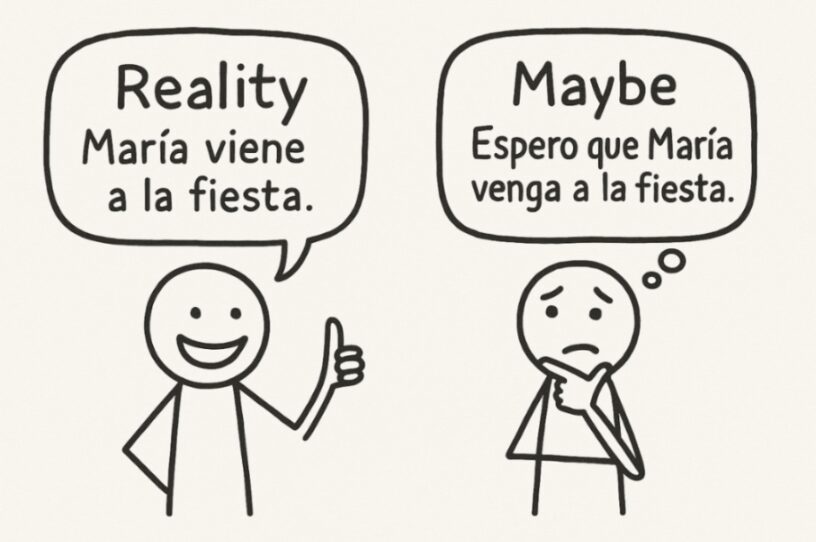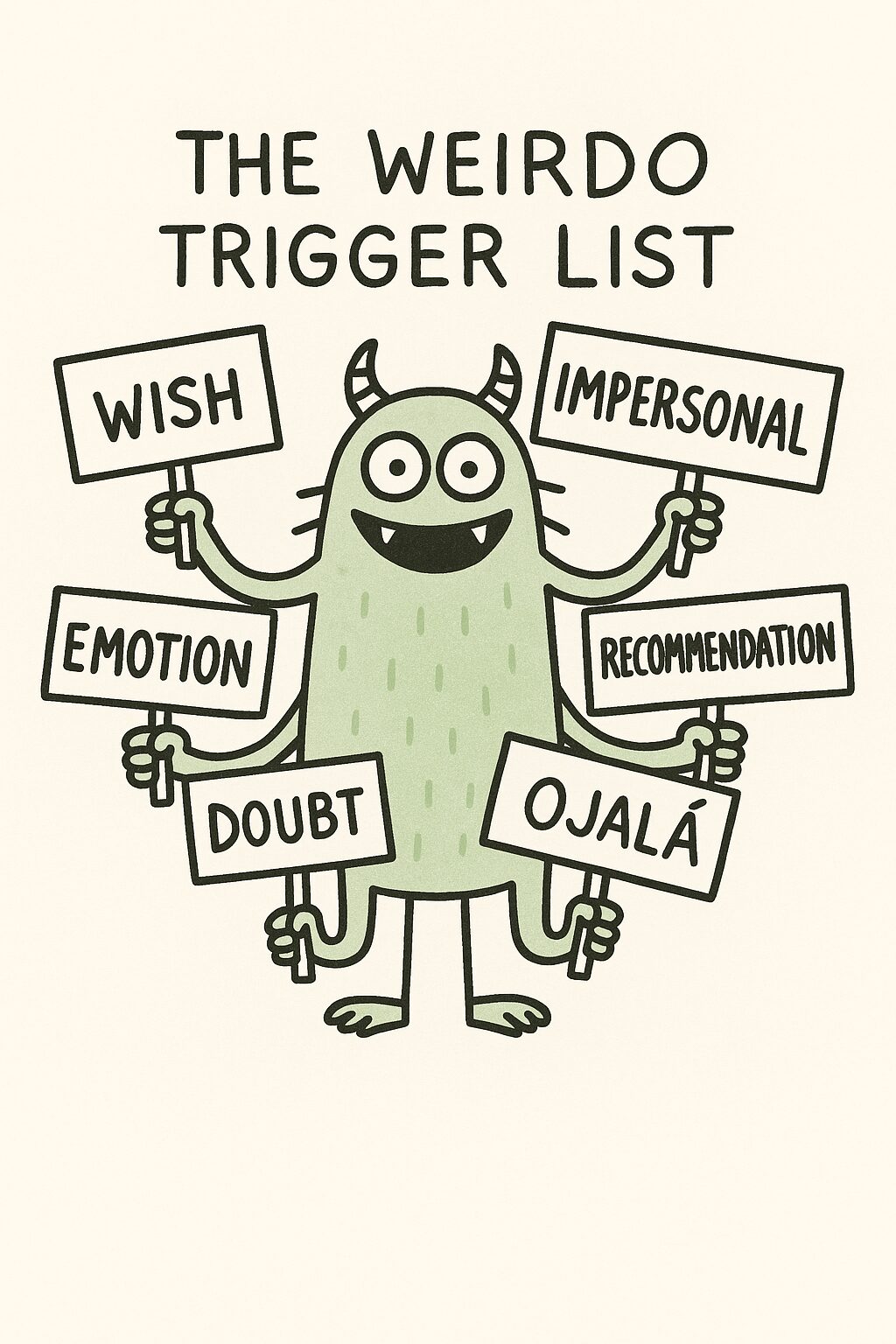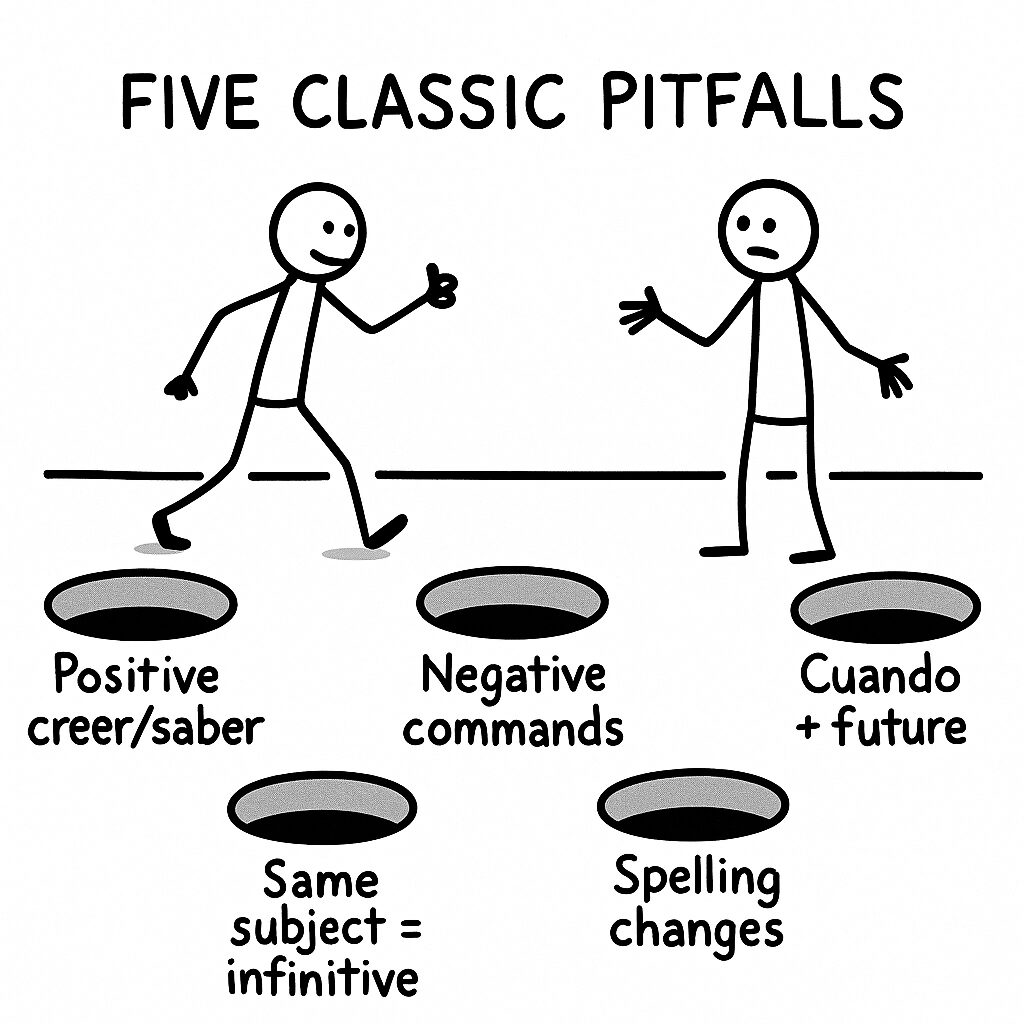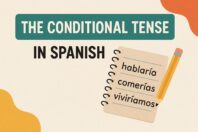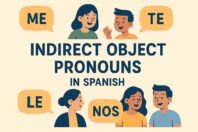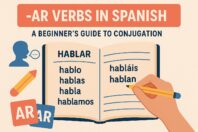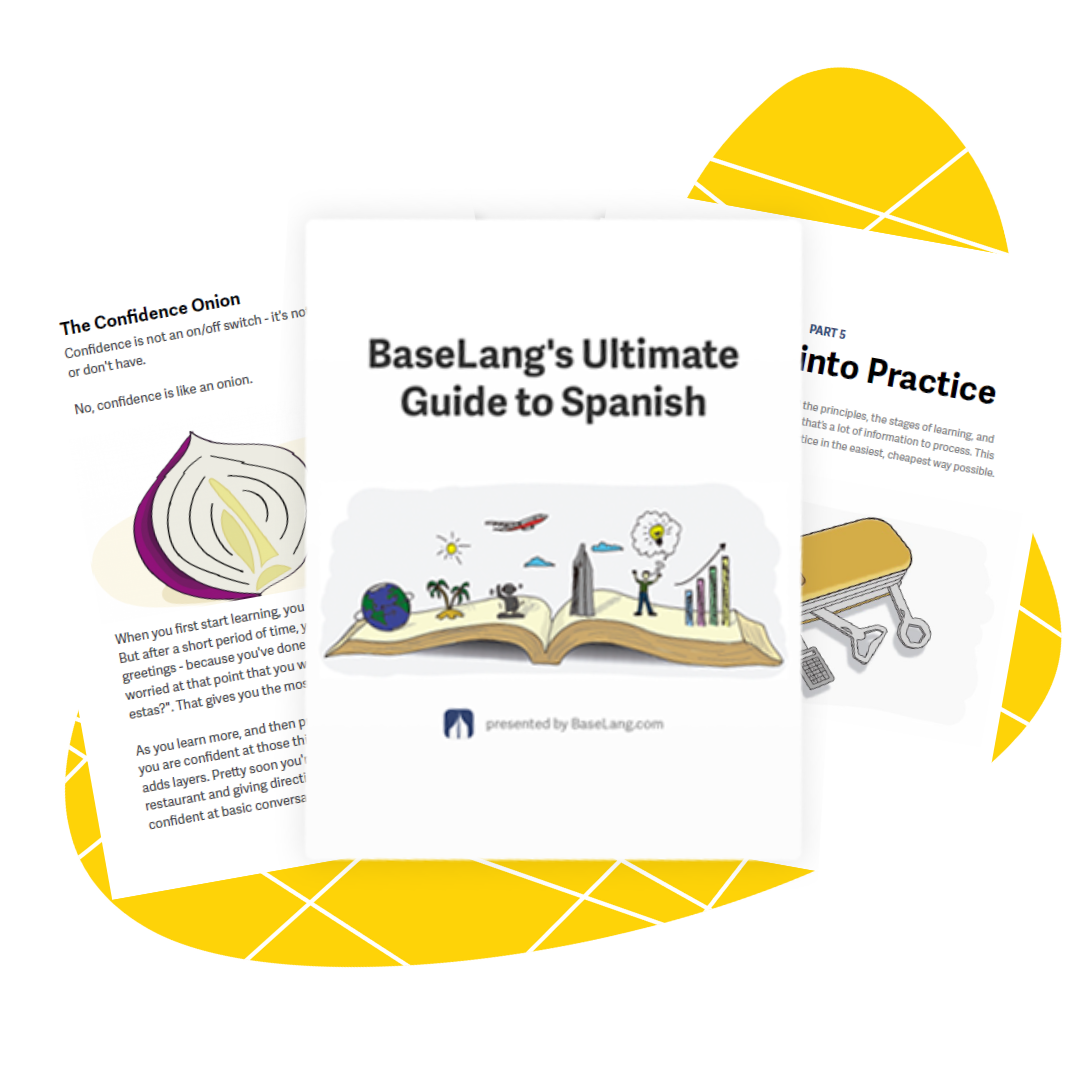The Subjunctive in Spanish, Simplified For Beginners
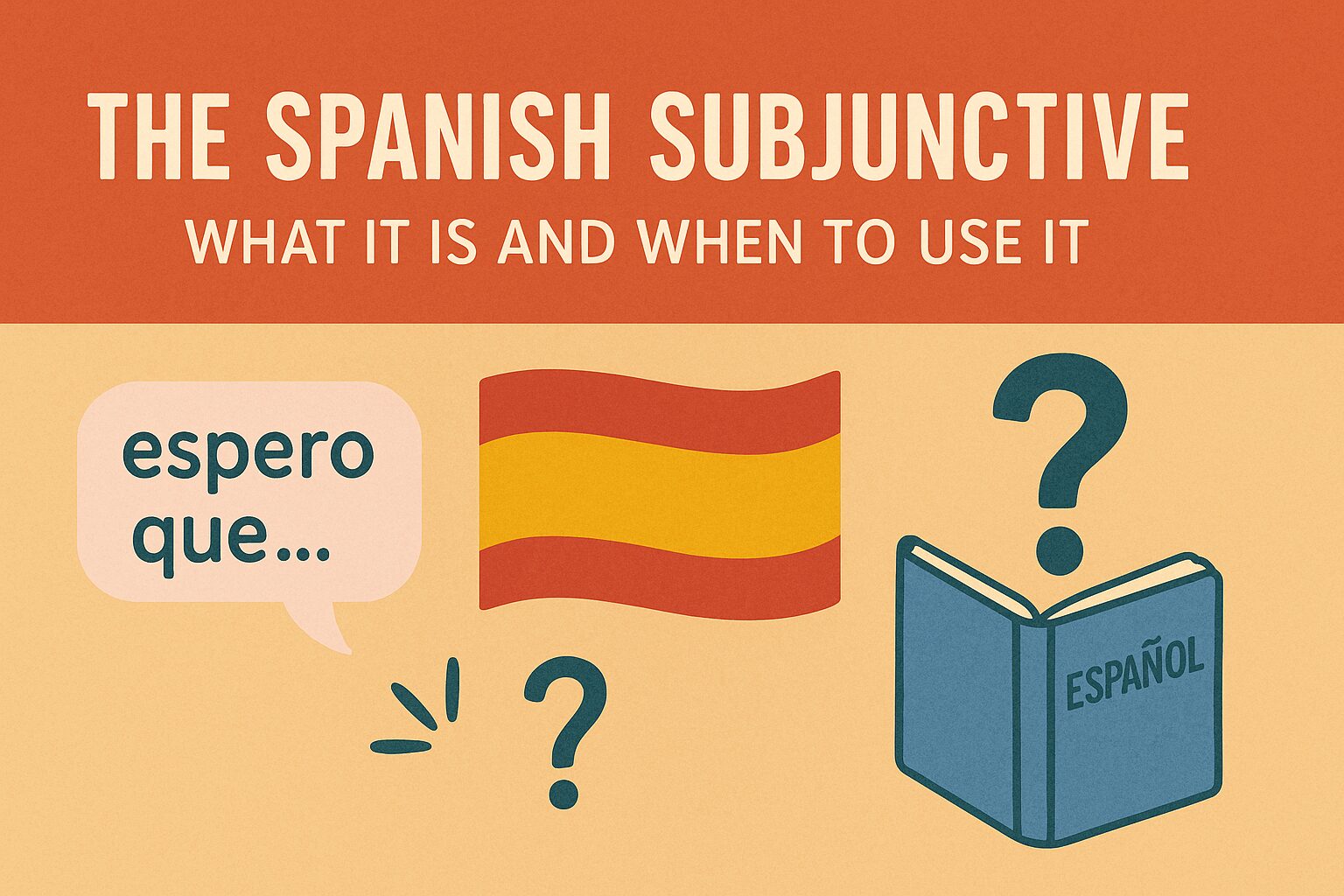
Get our free email course, Shortcut to Conversational.
Have conversations faster, understand people when they speak fast, and other tested tips to learn faster.
More infoIf the words “Spanish subjunctive” make you want to run for the hills, you’re not alone. It’s one of the most dreaded topics for Spanish learners, but it doesn’t have to be. The subjunctive is simply a tool for expressing uncertainty, emotion, hope, or anything that hasn’t happened yet.
For example, in “Espero que tengas un buen día,” “tengas” is the subjunctive because it expresses a wish.
In this guide, you’ll learn:
- What the Spanish subjunctive is
- When to use it
- The four essential subjunctive tenses
- How to avoid common mistakes
- Bite-size practice to lock it in
Ready? ¡Vamos!
What is the Spanish subjunctive?
The Spanish subjunctive is a verb mood we use for things that aren’t certain: wishes, doubts, feelings, and possibilities. You can think of it like English “may/might/hopefully.”
Many sentences have two parts: a main idea and a part that depends on it (a subordinate clause), often after “que”.
For example: “Quiero que vengas.” Here “quiero” is the main idea and “que vengas” depends on it. Another clear case is “Es importante que estudies.”
It’s not only verbs that can lead to the subjunctive. Nouns, adjectives, set phrases, and some prepositions can trigger it too:
- “La posibilidad de que llueva es alta.” — “There’s a high chance it will rain.”
- “Es bueno que practiques.” — “It’s good that you practice.”
- “Antes de que salgas, avísame.” — “Before you leave, let me know.”
Words of doubt like “acaso”, “quizá(s)”, and “tal vez” can take either indicative or subjunctive. Use this quick guide:
- Before the verb → usually subjunctive: “Tal vez llueva mañana.”
- After the verb → usually indicative: “Mañana llueve, tal vez.”
A simple way to decide: if it’s a wish or not 100% certain, expect the subjunctive (“Espero que tengas tiempo hoy.”); if it’s a straight fact, expect the indicative (“Hoy tienes tiempo.”).
What’s the difference between a Spanish mood and tense?
The subjunctive isn’t a tense; it’s a mood. Tenses tell time (past, present, future). Moods show attitude (fact, command, wish). In Spanish, there are three moods:
- Indicative: Facts and certainty
- Imperative: Direct commands
- Subjunctive: Wishes, doubts, emotions, hypotheticals
| Mood | Example | Why |
| Indicative | María viene a la fiesta. — María is coming. | The speaker treats it as fact. |
| Imperative | María, ven a la fiesta. — María, come to the party. | The speaker tells someone what to do. |
| Subjunctive | Espero que María venga a la fiesta. — I hope María comes. | It’s only a wish: uncertain. |
When and how to use the Spanish subjunctive
How do you know when to bust out the subjunctive?
Remember the W.E.I.R.D.O. acronym: six big reasons the subjunctive appears after que:
| Letter | Trigger | Example |
| W | Wishes & wants | Quiero que llames. — I want you to call. |
| E | Emotions | Me alegra que estés aquí. — I’m glad you’re here. |
| I | Impersonal phrases | Es necesario que estudies. — It’s necessary that you study. |
| R | Recommendations/requests | Te recomiendo que leas esto. |
| D | Doubt/denial | Dudo que sea cierto. — I doubt it’s true. |
| O | Ojalá (“hopefully”) | Ojalá que gane tu equipo. |
Two key reminders
- A subjunctive clause almost always has its own subject (often different from the main clause).
Quiero que tú vengas. — “I want you to come.” - If there’s no new subject, Spanish keeps the verb in the infinitive:
Quiero ir temprano (I want to go early).
The four Spanish subjunctive tenses used by native speakers
Spanish uses the subjunctive mood in four tenses. Master these four and you’re set.
| Tense | Use it when | Build it | Endings / keys |
| Present subjunctive | You’re not sure about now or the future; all negative commands | Take the “yo” in present, drop “-o,” and add the opposite endings | • -ar → e, es, e, emos, éis, en
• -er/-ir → a, as, a, amos, áis, an • Start with “yo” to keep the weird stems/spelling changes |
| Present perfect subjunctive | You’re not sure about something that just happened | haber in present subjunctive + past participle | haya, hayas, haya, hayamos, hayáis, hayan + -ado/-ido (or irregular participle) |
| Imperfect (past) subjunctive | Past wishes/requests; polite softeners; unreal “if” ideas | Take ellos preterite, drop “-ron,” add -ra endings | • -ra, -ras, -ra, -ramos (accent), -rais, -ran
• -se forms also exist (same meaning) |
| Past perfect (pluperfect) subjunctive | Regrets or “what if” about an earlier past | haber in imperfect subjunctive + past participle | • hubiera, hubieras, hubiera, hubiéramos, hubierais, hubieran (+ participle)
• hubiese series also exists |
1) Present subjunctive
Quick examples
-
-
- hablar → hablo → habl- → hable, hables, hable, hablemos, habléis, hablen
- tener → tengo → teng- → tenga, tengas, tenga, tengamos, tengáis, tengan
- pensar → pienso → piens- → piense, pienses, piense, pensemos, penséis, piensen (note the stem change pattern)
-
Most common irregulars (infinitive → yo form)
-
-
- ser → sea, estar → esté, ir → vaya, tener → tenga, saber → sepa, dar → dé
-
Example sentences
-
-
- Es importante que ellos lleguen a tiempo. — “It is important that they arrive on time.”
- Dudo que Marta sepa la verdad. — “I doubt that Marta knows the truth.”
- No tengas miedo. (negative command → subjunctive) — “Do not be afraid.”
-
2) Present perfect subjunctive
Examples
-
-
- Me alegra que vosotros hayáis aprobado el examen. — “I’m glad you (plural, Spain) have passed the exam.”
- Es posible que él haya olvidado la cita. — “It’s possible that he has forgotten the appointment.”
- No creo que nosotros hayamos comido suficiente. — “I don’t think we have eaten enough.”
-
3) Imperfect (past) subjunctive
Example build
-
-
- hablar → hablaron → habla- → hablara, hablaras, hablara, habláramos, hablarais, hablaran
- tener → tuvieron → tuvie- → tuviera, tuvieras, tuviera, tuviéramos, tuvierais, tuvieran
-
Note: You can also use the -se series (hablase, tuviese, etc.). Same meaning; the -ra series is more common in everyday speech.
Examples
-
-
- Si yo tuviera alas, volaría. — “If I had wings, I would fly.”
- El jefe pidió que Ana escribiera el informe. — “The boss asked that Ana write the report.”
- Era una lástima que vosotros no vinieráis más a menudo. — “It was a shame that you (plural, Spain) didn’t come more often.
-
4) Past perfect (pluperfect) subjunctive
Examples
-
- Ojalá hubiera estudiado más para el examen. — “I wish I had studied more for the exam.”
- No creí que ellos hubieran llegado tan temprano. — “I didn’t think they had arrived so early.”
- Si tú hubieras visto la película, entenderías la referencia. — “If you had seen the movie, you would understand the reference.”
Spanish subjunctive vs. indicative: Which one to use?
Think of the indicative as Spanish’s default mode for plain, objective reality, and the subjunctive as the mood for everything that lives in the land of maybe: hopes, doubts, emotions, uncertainty.
As soon as the main clause shows any shade of doubt, wish, recommendation, or future uncertainty, the verb in the second clause flips to the subjunctive.
| Situation | Indicative (certainty, fact) | Subjunctive (uncertainty, subjectivity) |
| Belief / certainty | Creo que él tiene razón. — I think he is right. | No creo que él tenga razón. — I don’t think he is right. |
| Observation / perception | Veo que tú estás cansado. — I can see you’re tired. | Espero que tú estés descansado. — I hope you’re rested. |
| Implied possibility | Es cierto que María viene hoy. — It’s certain María is coming today. | Es posible que María venga hoy. — It’s possible María may come today. |
| Desire / wish | Quiero decir la verdad. — I want to tell the truth. (same subject ⇒ infinitive) | Quiero que tú digas la verdad. — I want you to tell the truth. |
| Time clause (future) | Cuando llegó Juan, empezamos. — When Juan arrived, we started. (completed past event) | Cuando Juan llegue, empezaremos. — When Juan arrives, we’ll start. (future, not certain yet) |
Five classic pitfalls (and fixes)
- “Creer” or “saber” in positive sentences → use the indicative
If you believe or know something is true, treat it as a fact.
✅ Creo que es bueno. (I believe it’s good.)
❌ Creo que sea bueno. (Wrong!) - Negative commands → use the subjunctive
When you tell someone not to do something, the verb goes in the subjunctive.
No vengas, no digas, no toques.
(Do come = ven. Don’t come = no vengas.) - Same subject? Use the infinitive, not the subjunctive
If both parts of the sentence have the same person, don’t repeat the subject, just use the verb in infinitive.
Prefiero estudiar aquí. (I prefer to study here.)
Not: Prefiero que estudie aquí. - “Cuando” + future → use present subjunctive
After cuando (when), if the action hasn’t happened yet, use the subjunctive.
Cuando termine, saldremos. (When I finish, we’ll leave.)
But if it already happened:
Cuando terminé, salimos. (When I finished, we left.) → indicative - Spelling changes keep the original sound
Some verbs change spelling in the subjunctive so the sound stays the same.
- buscar → busque (to keep the “k” sound)
- pagar → pague (to keep the “g” sound)
- empezar → empiece (to keep the “s” sound soft)
Exercises: Spanish subjunctive practice
Fill in each blank with the correct subjunctive form (present, imperfect, perfect, or pluperfect as context requires).
- Quiero que tú ______ (venir) conmigo.
- Me alegra que ustedes ______ (haber) llegado.
- No es cierto que ella ______ (saber) la respuesta.
- Si yo ______ (ser) tú, lo pensaría dos veces.
- Ojalá que mañana no ______ (llover).
- Dudaba que ellos ______ (poder) terminar a tiempo.
- Me gustaría que él me ______ (llamar) ayer.
- Es posible que Marta ______ (comprar) el coche hoy.
- Espero que mis padres me ______ (enviar) un mensaje.
- No creo que nosotros ______ (tener) suficiente dinero.
- Cuando ______ (llegar) Juan, empezaremos la reunión.
- Busco un libro que ______ (explicar) bien el subjuntivo.
- Fue una lástima que tú no ______ (venir) a la fiesta anoche.
- Tan pronto como él ______ (terminar) el trabajo, saldremos.
- Me sorprendió que ustedes ya ______ (comer) cuando llegué.
- A menos que ella ______ (estudiar) más, no aprobará.
- Aunque ______ (ser) caro, lo compraré.
- No toques eso hasta que el pegamento ______ (secar).
- Era importante que tú ______ (hablar) con el jefe antes.
- Ojalá que para entonces ya ______ (resolver) el problema.
Answers
- vengas
- hayan
- sepa
- fuera
- llueva
- pudieran
- hubiera llamado
- compre
- envíen
- tengamos
- llegue
- explique
- vinieras
- termine
- hubieran comido
- estudie
- sea
- seque
- hablaras
- hayamos resuelto
Subjunctive Spanish study hacks
- Shadow WEIRDO phrases. Record yourself saying “Espero que…”, “Dudo que…”, “Ojalá que…” with made-up endings. Repetition breeds instinct.
- Swap endings drill. Pick any ten verbs, form the yo-present, drop –o, add opposite vowels aloud: quickest muscle memory ever.
- Mini-stories. Write three-line comic strips: a desire, a doubt, an if-only regret. Label each verb tense in color.
- Negative-command sticky notes. Put No toques, No comas, No digas on your fridge for daily exposure.
Key takeaways
Subjunctive shows uncertainty; indicative shows fact.
- Triggers? Think WEIRDO.
- Core tenses:
- Present (hable)
- Present perfect (haya hablado)
- Imperfect (hablara)
- Past perfect (hubiera hablado)
- Negative commands = present subjunctive.
Conclusion: The Spanish subjunctive mood
The Spanish language invented the subjunctive to talk about the gray areas of life: hopes, doubts, possibilities, and polite suggestions.
Yes, new endings feel awkward at first, but they unlock a richer, more polite Spanish. Start weaving in short, real-life lines:
- Ojalá que tengas tiempo.
- No creo que sea tarde.
- Es mejor que vayamos.
Say them in front of a mirror, doodle the WEIRDO monster in your notes, and repeat until the “maybe” mood feels natural. Little by little, the subjunctive will stop looking weird and start feeling like a superpower.
